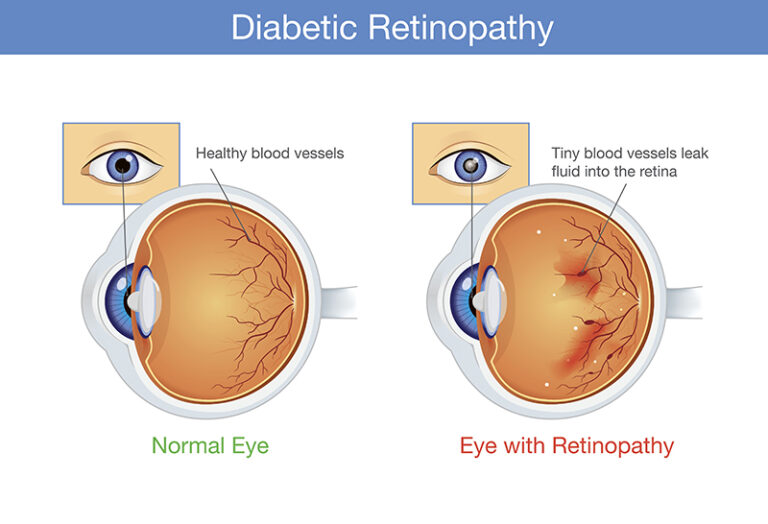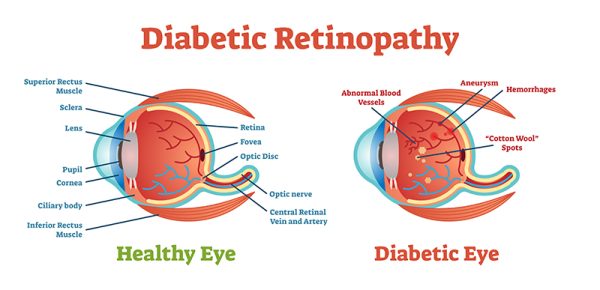
What is Diabetic Retinopathy?
Diabetic retinopathy is an eye condition that affects those with diabetes. It occurs when there is damage done to the blood vessels in the retina. This complication can appear in both types of diabetes, type 1 and 2, and though symptoms may be mild at first, it can eventually lead to blindness.
This eye condition occurs in two stages. NPDR (non-proliferative diabetic retinopathy) is the first stage, and is fairly common for those with diabetes to have. In this stage, tiny blood vessels leak, causing the retina to swell. This is referred to as macular edema. These blood vessels may also begin to close off, blocking blood from reaching the center portion of the retina, or macula, and sometimes causing deposits of particles, called exudates, to form in the retina. If untreated, these changes may cause vision changes or even blindness.
The more severe stage of diabetic retinopathy is called proliferative diabetic retinopathy. This stage occurs when new blood vessels in the retina begin to form. This is referred to as neovascularization. In diabetic retinopathy, this happens due to the damaged blood vessels that begin to close off. Because these new blood vessels are fragile, they often bleed into the virteous, or the clear jelly-like substance that fills the center of the eye. This is known as a vitreous hemorrhage. These new blood vessels also cause scar tissue to form which leads to retinal detachment, complications with the macula, and glaucoma due to a resulting buildup of eye pressure. All of these may lead to serious vision loss or blindness.
What are the symptoms of Diabetic Retinopathy?
Oftentimes, there are no symptoms in its early stages. However, as the condition progresses, you may experience symptoms such as:
- Blurry/Double vision
- Seeing flashes of light or floating spots in your vision (Known as flashes and floaters)
- Blank or dark areas in your vision
- Reduced or low vision
- Pain or pressure in one or both eyes
If you are experiencing a combination of these symptoms, please see your doctor as soon as possible to prevent any, or further, vision loss from happening.
What are the causes of Diabetic Retinopathy?
When we eat, your body breaks down food into glucose (sugar), and then a peptide hormone called insulin, moves this glucose from your blood into different cells. When your body lacks enough insulin or your diet is too rich in sugars and forms of glucose, this can result in blood sugar levels rising higher than normal. This is known as having high blood sugar. Diabetes is often associated with hyperglycemia and high blood sugar, and the longer you have diabetes and the less you monitor and maintain adequate blood sugar levels, the more prone you are to medical complications associated with this issue.
Diabetic Retinopathy is a common condition for those with diabetes because it is caused when too much sugar is in the blood, creating blockages in the bloodstream. These blockages result in changes to the blood vessels in the retina and cut off its bloody supply. This is crucial because blood carries important nutrients and without it, the retina will begin to deteriorate. Once blockages occur, the body responds by attempting to develop new blood vessels in its place. However, these blood vessels are very fragile and often do not develop properly, which causes leaking and swelling and results in major eye and vision complications.
How will I know if I have it or am at risk? What are the treatment options?
Although symptoms for diabetic retinopathy do not usually occur in its early stages, you may be aware of signs which may indicate you have diabetic retinopathy. This includes:
- Fluctuating vision
- Reduced or low vision
- Trouble seeing at night or in dim lighting
- Colors beginning to look washed out or faded
Because of the effects of diabetes on the blood, anyone with diabetes is prone to diabetic retinopathy. There are however, risk factors that may raise your risk of developing this condition that you may cautious of, such as:
- Pregnancy
- Tobacco use
- Poor control of blood sugar levels
- High blood pressure
- High cholesterol
- Race (Black, Hispanic, and Native American ethnicities show the highest risk)
Unfortunately, the longer you have diabetes, the higher the risk is of developing diabetic retinopathy. That is why it is crucial for those with diabetes to receive a dilated eye exam every year. Through this, your doctor will be able to check your signs in the retina and other parts of the eye, and diagnose any eye conditions that may be brought on by diabetes, and come up with a treatment plan. If you have diabetes and become pregnant, we highly suggest receiving a dilated eye exam in your first trimester and throughout the pregnancy, up to one year after.
Diabetic retinopathy can not always be prevented, but severe vision loss and eye problems resulting from diabetic retinopathy can be. This can be done by:
- Monitoring and maintaining your blood sugar levels
- Keeping your blood pressure and cholesterol under control
- Eating a healthy and balanced diet
- Keeping your body active
- Quitting smoking and tobacco use
- Testing hemoglobin A1c levels regularly
- Testing urine for ketone levels regularly
- Taking medication as directed and on schedule
- Using Insulin as directed
If the condition does become advanced, there are other options to treat it before damage to the retina becomes too severe and vision loss occurs. Medications such as anti-VEGF medication, including Avastin, Eylea, and Lucentis, or steroid medications can be injected into the eye to reduce macular swelling and slow the growth of abnormal blood vessels and vision loss. In some cases, vision has improved after this procedure. Your doctor may recommend multiple shots over the course of years.
Surgical options to treat diabetic retinopathy include laser surgery and vitrectomy. Laser surgery is done using a laser that is used to shrink abnormal blood vessels and seal leaking ones. This can also reduce swelling in the retina and prevent new blood vessels from forming. Vitrectomy is another surgical option, where an ophthalmologist will remove vitreous gel and blood caused by leaking blood vessels in the back of the eye. Scar tissue in the retina may also be removed. The ophthalmologist will then replace the vitreous with a balanced saline solution, allowing light rays to properly focus on the retina once again.
Remember, diabetes does not mean inevitable vision loss. With the proper management and an active healthy lifestyle, you can live life to the fullest and without serious health complications brought on by diabetes.



